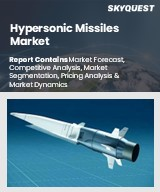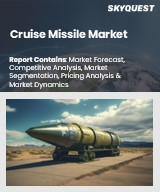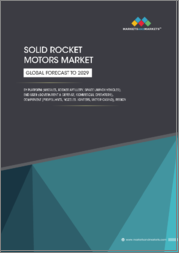
|
시장보고서
상품코드
1820125
순항 미사일 시장 보고서 : 발사 플랫폼별, 속도별, 사정거리별, 용도별, 지역별(2025-2033년)Cruise Missile Market Report by Launch Platform, Speed, Range, Application, and Region 2025-2033 |
||||||
세계 순항 미사일 시장 규모는 2024년 20억 달러에 달했습니다. 향후 IMARC Group은 이 시장이 2033년까지 34억 달러에 달해 2025년부터 2033년까지 6.1%의 연평균 성장률(CAGR)을 보일 것으로 예측하고 있습니다.
순항 미사일은 표적 탄두를 정밀하게 발사하기 위한 무인 자행 유도 미사일을 말합니다. 자기항행이 가능하며, 비탄도-저고도 궤도를 비행하며 초음속-극초음속으로 이동합니다. 순항 미사일은 유도장치, 탑재체, 항공기 추진장치로 구성되며, 기체에 탑재되어 육상, 해상, 공중 플랫폼을 통해 발사할 수 있습니다. 지형 매핑, 전지구측위시스템(GPS), 관성 유도, 모션 센서, 자이로스코프 등 다양한 기술을 활용하여 미리 프로그래밍된 비행 경로를 유지합니다. 미사일은 또한 지대지, 지대공, 지대공, 공대공, 공대지, 해저에서 지표면으로의 발사 모드에 맞게 프로그래밍되어 있습니다. 고체, 액체, 하이브리드, 램 제트, 터보 제트, 스크럼 제트 추진 시스템을 사용합니다.
순항 미사일 시장 동향:
전 세계적으로 국경을 초월한 선동과 테러 활동의 증가는 시장 성장을 촉진하는 중요한 요인 중 하나입니다. 순항 미사일은 방어 전략을 실행하고, 테러리스트의 위협과 정치적, 영토적 문제에 대응하기 위해 매우 중요합니다. 또한, 상황 인식과 목표 정확도를 강화하기 위한 방위 시스템에 인공지능(AI) 기술의 통합이 시장 성장의 원동력이 되고 있습니다. 음속 이상의 속도로 이동할 수 있는 혁신적인 극초음속 순항 미사일 개발 등 다양한 기술 발전도 성장을 촉진하는 요인으로 작용하고 있습니다. 이 미사일은 매우 강력하고 장거리 전략 핵 공격에도 사용할 수 있습니다. 또한, 신형 미사일은 전자적 대응 조치에 내성이 있으며, 미사일을 수평으로 재배치하고 공습에 대응하여 기동할 수 있는 각형 추진기를 갖추고 있습니다. 기존 방위 시스템의 급속한 현대화, 3D 프린터로 제조된 미사일 부품 및 구조물의 광범위한 채택 등 다른 요인들도 시장 성장을 촉진할 것으로 예상됩니다.
본 보고서에서 다루는 주요 질문
- 순항 미사일 세계 시장 규모는?
- 순항 미사일 세계 시장의 2025-2033년 예상 성장률은?
- 순항 미사일 세계 시장을 주도하는 주요 요인은?
- COVID-19가 순항 미사일 세계 시장에 미치는 영향은?
- 세계 순항 미사일 시장의 발사 플랫폼별 분류는?
- 순항 미사일 세계 시장에서의 속도별 분류는?
- 순항 미사일 세계 시장의 주요 지역은?
- 세계 순항 미사일 시장의 주요 기업은?
목차
제1장 서문
제2장 조사 범위와 조사 방법
- 조사 목적
- 이해관계자
- 데이터 소스
- 1차 정보
- 2차 정보
- 시장 추정
- 상향식 접근
- 하향식 접근
- 조사 방법
제3장 주요 요약
제4장 소개
제5장 세계의 순항 미사일 시장
- 시장 개요
- 시장 실적
- COVID-19의 영향
- 시장 예측
제6장 시장 내역 : 발사 플랫폼별
- 공중
- 수상 전투원
- 육상
- 잠수함
제7장 시장 내역 : 속도별
- 아음속
- 초음속
- 극초음속
제8장 시장 내역 : 사정거리별
- 단거리 미사일
- 중거리 미사일
- 장거리 미사일
제9장 시장 내역 : 용도별
- 공격
- 수비
제10장 시장 내역 : 지역별
- 북미
- 미국
- 캐나다
- 아시아태평양
- 중국
- 일본
- 인도
- 한국
- 호주
- 인도네시아
- 기타
- 유럽
- 독일
- 프랑스
- 영국
- 이탈리아
- 스페인
- 러시아
- 기타
- 라틴아메리카
- 브라질
- 멕시코
- 기타
- 중동 및 아프리카
제11장 SWOT 분석
제12장 밸류체인 분석
제13장 Porter's Five Forces 분석
제14장 가격 분석
제15장 경쟁 구도
- 시장 구조
- 주요 기업
- 주요 기업 개요
- Aerojet Rocketdyne Inc.
- Avibras Industria Aeroespacial SA
- China Aerospace Science and Industry Corporation Limited
- Defence Research and Development Organisation
- Kongsberg Gruppen
- Lockheed Martin Corporation
- MBDA
- Raytheon Technologies Corporation
- Roketsan Roket Sanayii ve Ticaret AS
- The Boeing Company
The global cruise missile market size reached USD 2.0 Billion in 2024. Looking forward, IMARC Group expects the market to reach USD 3.4 Billion by 2033, exhibiting a growth rate (CAGR) of 6.1% during 2025-2033.
Cruise missile refers to an unmanned, self-propelled and guided missile used for delivering targeted warheads with enhanced precision. It can self-navigate, fly on a non-ballistic and low-altitude trajectory and travel at supersonic and hypersonic speeds. Cruise missiles consist of a guidance, payload and aircraft propulsion system that is enclosed in an airframe and can be launched using land, sea and air-based platforms. They use various technologies, such as terrain mapping, global positioning systems (GPS), inertial guidance, motion sensors and gyroscopes to maintain a pre-programmed flight path. The missiles are also programmed for surface-to-surface, surface-to-air, air-to-air, air-to-surface and subsea to surface launch modes. They use solid, liquid, hybrid, ramjet, turbojet and scramjet propulsion systems.
Cruise Missile Market Trends:
The rising incidence of cross-border agitations and terrorist activities across the globe is one of the key factors driving the growth of the market. Cruise missiles are crucial for enforcing defense strategies and countering terrorist threats and political and territorial issues. Moreover, the integration of artificial intelligence (AI) technology in defense systems for enhanced situational awareness and target precision is providing a thrust to the market growth. Various technological advancements, such as the development of innovative hypersonic cruise missiles that can travel faster than the speed of sound, are acting as other growth-inducing factors. These missiles are highly powerful and can be used for delivering long-range strategic nuclear strikes. Novel variants are also resistant to electronic countermeasures and are equipped with angular thrusters to reposition the missile horizontally and maneuver against airstrikes. Other factors, including the rapid modernization of existing defense systems, along with the widespread adoption of 3D printed missile components and structures, are anticipated to drive the market toward growth.
Key Market Segmentation:
Breakup by Launch Platform:
- Air
- Surface Combatants
- Land
- Submarine
Breakup by Speed:
- Subsonic
- Supersonic
- Hypersonic
Breakup by Range:
- Short-range Missiles
- Medium-range Missiles
- Long-range Missiles
Breakup by Application:
- Attack
- Defensive
Breakup by Region:
- North America
- United States
- Canada
- Asia-Pacific
- China
- Japan
- India
- South Korea
- Australia
- Indonesia
- Others
- Europe
- Germany
- France
- United Kingdom
- Italy
- Spain
- Russia
- Others
- Latin America
- Brazil
- Mexico
- Others
- Middle East and Africa
Competitive Landscape:
The competitive landscape of the industry has also been examined along with the profiles of the key players being Aerojet Rocketdyne Inc., Avibras Industria Aeroespacial SA, China Aerospace Science and Industry Corporation Limited, Defence Research and Development Organisation, Kongsberg Gruppen, Lockheed Martin Corporation, MBDA, Raytheon Technologies Corporation, Roketsan Roket Sanayii ve Ticaret AS and The Boeing Company.
Key Questions Answered in This Report
- 1.How big is the global cruise missile market?
- 2.What is the expected growth rate of the global cruise missile market during 2025-2033?
- 3.What are the key factors driving the global cruise missile market?
- 4.What has been the impact of COVID-19 on the global cruise missile market?
- 5.What is the breakup of the global cruise missile market based on the launch platform?
- 6.What is the breakup of the global cruise missile market based on the speed?
- 7.What are the key regions in the global cruise missile market?
- 8.Who are the key players/companies in the global cruise missile market?
Table of Contents
1 Preface
2 Scope and Methodology
- 2.1 Objectives of the Study
- 2.2 Stakeholders
- 2.3 Data Sources
- 2.3.1 Primary Sources
- 2.3.2 Secondary Sources
- 2.4 Market Estimation
- 2.4.1 Bottom-Up Approach
- 2.4.2 Top-Down Approach
- 2.5 Forecasting Methodology
3 Executive Summary
4 Introduction
- 4.1 Overview
- 4.2 Key Industry Trends
5 Global Cruise Missile Market
- 5.1 Market Overview
- 5.2 Market Performance
- 5.3 Impact of COVID-19
- 5.4 Market Forecast
6 Market Breakup by Launch Platform
- 6.1 Air
- 6.1.1 Market Trends
- 6.1.2 Market Forecast
- 6.2 Surface Combatants
- 6.2.1 Market Trends
- 6.2.2 Market Forecast
- 6.3 Land
- 6.3.1 Market Trends
- 6.3.2 Market Forecast
- 6.4 Submarine
- 6.4.1 Market Trends
- 6.4.2 Market Forecast
7 Market Breakup by Speed
- 7.1 Subsonic
- 7.1.1 Market Trends
- 7.1.2 Market Forecast
- 7.2 Supersonic
- 7.2.1 Market Trends
- 7.2.2 Market Forecast
- 7.3 Hypersonic
- 7.3.1 Market Trends
- 7.3.2 Market Forecast
8 Market Breakup by Range
- 8.1 Short-range Missiles
- 8.1.1 Market Trends
- 8.1.2 Market Forecast
- 8.2 Medium-range Missiles
- 8.2.1 Market Trends
- 8.2.2 Market Forecast
- 8.3 Long-range Missiles
- 8.3.1 Market Trends
- 8.3.2 Market Forecast
9 Market Breakup by Application
- 9.1 Attack
- 9.1.1 Market Trends
- 9.1.2 Market Forecast
- 9.2 Defensive
- 9.2.1 Market Trends
- 9.2.2 Market Forecast
10 Market Breakup by Region
- 10.1 North America
- 10.1.1 United States
- 10.1.1.1 Market Trends
- 10.1.1.2 Market Forecast
- 10.1.2 Canada
- 10.1.2.1 Market Trends
- 10.1.2.2 Market Forecast
- 10.1.1 United States
- 10.2 Asia-Pacific
- 10.2.1 China
- 10.2.1.1 Market Trends
- 10.2.1.2 Market Forecast
- 10.2.2 Japan
- 10.2.2.1 Market Trends
- 10.2.2.2 Market Forecast
- 10.2.3 India
- 10.2.3.1 Market Trends
- 10.2.3.2 Market Forecast
- 10.2.4 South Korea
- 10.2.4.1 Market Trends
- 10.2.4.2 Market Forecast
- 10.2.5 Australia
- 10.2.5.1 Market Trends
- 10.2.5.2 Market Forecast
- 10.2.6 Indonesia
- 10.2.6.1 Market Trends
- 10.2.6.2 Market Forecast
- 10.2.7 Others
- 10.2.7.1 Market Trends
- 10.2.7.2 Market Forecast
- 10.2.1 China
- 10.3 Europe
- 10.3.1 Germany
- 10.3.1.1 Market Trends
- 10.3.1.2 Market Forecast
- 10.3.2 France
- 10.3.2.1 Market Trends
- 10.3.2.2 Market Forecast
- 10.3.3 United Kingdom
- 10.3.3.1 Market Trends
- 10.3.3.2 Market Forecast
- 10.3.4 Italy
- 10.3.4.1 Market Trends
- 10.3.4.2 Market Forecast
- 10.3.5 Spain
- 10.3.5.1 Market Trends
- 10.3.5.2 Market Forecast
- 10.3.6 Russia
- 10.3.6.1 Market Trends
- 10.3.6.2 Market Forecast
- 10.3.7 Others
- 10.3.7.1 Market Trends
- 10.3.7.2 Market Forecast
- 10.3.1 Germany
- 10.4 Latin America
- 10.4.1 Brazil
- 10.4.1.1 Market Trends
- 10.4.1.2 Market Forecast
- 10.4.2 Mexico
- 10.4.2.1 Market Trends
- 10.4.2.2 Market Forecast
- 10.4.3 Others
- 10.4.3.1 Market Trends
- 10.4.3.2 Market Forecast
- 10.4.1 Brazil
- 10.5 Middle East and Africa
- 10.5.1 Market Trends
- 10.5.2 Market Breakup by Country
- 10.5.3 Market Forecast
11 SWOT Analysis
- 11.1 Overview
- 11.2 Strengths
- 11.3 Weaknesses
- 11.4 Opportunities
- 11.5 Threats
12 Value Chain Analysis
13 Porters Five Forces Analysis
- 13.1 Overview
- 13.2 Bargaining Power of Buyers
- 13.3 Bargaining Power of Suppliers
- 13.4 Degree of Competition
- 13.5 Threat of New Entrants
- 13.6 Threat of Substitutes
14 Price Analysis
15 Competitive Landscape
- 15.1 Market Structure
- 15.2 Key Players
- 15.3 Profiles of Key Players
- 15.3.1 Aerojet Rocketdyne Inc.
- 15.3.1.1 Company Overview
- 15.3.1.2 Product Portfolio
- 15.3.1.3 Financials
- 15.3.1.4 SWOT Analysis
- 15.3.2 Avibras Industria Aeroespacial SA
- 15.3.2.1 Company Overview
- 15.3.2.2 Product Portfolio
- 15.3.3 China Aerospace Science and Industry Corporation Limited
- 15.3.3.1 Company Overview
- 15.3.3.2 Product Portfolio
- 15.3.4 Defence Research and Development Organisation
- 15.3.4.1 Company Overview
- 15.3.4.2 Product Portfolio
- 15.3.5 Kongsberg Gruppen
- 15.3.5.1 Company Overview
- 15.3.5.2 Product Portfolio
- 15.3.5.3 Financials
- 15.3.6 Lockheed Martin Corporation
- 15.3.6.1 Company Overview
- 15.3.6.2 Product Portfolio
- 15.3.6.3 Financials
- 15.3.6.4 SWOT Analysis
- 15.3.7 MBDA
- 15.3.7.1 Company Overview
- 15.3.7.2 Product Portfolio
- 15.3.8 Raytheon Technologies Corporation
- 15.3.8.1 Company Overview
- 15.3.8.2 Product Portfolio
- 15.3.8.3 Financials
- 15.3.8.4 SWOT Analysis
- 15.3.9 Roketsan Roket Sanayii ve Ticaret AS
- 15.3.9.1 Company Overview
- 15.3.9.2 Product Portfolio
- 15.3.10 The Boeing Company
- 15.3.10.1 Company Overview
- 15.3.10.2 Product Portfolio
- 15.3.10.3 Financials
- 15.3.10.4 SWOT Analysis
- 15.3.1 Aerojet Rocketdyne Inc.

















